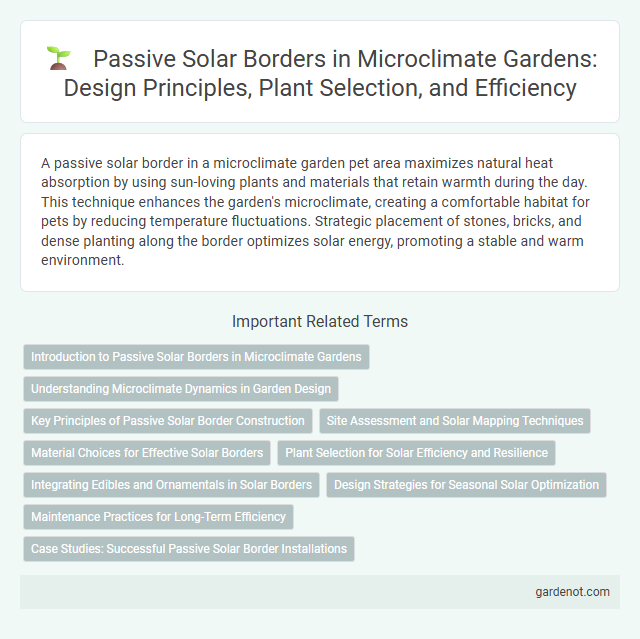A passive solar border in a microclimate garden pet area maximizes natural heat absorption by using sun-loving plants and materials that retain warmth during the day. This technique enhances the garden's microclimate, creating a comfortable habitat for pets by reducing temperature fluctuations. Strategic placement of stones, bricks, and dense planting along the border optimizes solar energy, promoting a stable and warm environment.
Introduction to Passive Solar Borders in Microclimate Gardens
Passive solar borders in microclimate gardens utilize sun-exposed plantings and materials to capture, absorb, and slowly release solar heat, enhancing temperature regulation and extending growing seasons. Strategic placement of heat-retentive stones or dense shrubs maximizes solar gain, creating warmer microhabitats that support diverse plant species. These borders contribute to frost protection and improved energy efficiency within garden spaces by moderating thermal fluctuations.
Understanding Microclimate Dynamics in Garden Design
Passive solar borders leverage strategic plant placement and materials to maximize sunlight absorption and heat retention, enhancing the garden's microclimate. Understanding microclimate dynamics involves analyzing factors such as solar radiation, wind patterns, and thermal mass to optimize temperature regulation and moisture control. This approach supports healthier plant growth by creating stable, energy-efficient environments that reduce the need for artificial heating or cooling.
Key Principles of Passive Solar Border Construction
Passive solar border construction maximizes solar energy absorption and thermal regulation by using south-facing plants and materials with high thermal mass, such as rocks or bricks, to store heat during the day and release it at night. Selecting drought-tolerant, sun-loving plant species reduces water use and enhances microclimate benefits, while layering plant heights improves airflow and shading. Proper soil preparation with organic mulch increases moisture retention and insulation, supporting sustainable temperature control in the garden.
Site Assessment and Solar Mapping Techniques
Site assessment for a passive solar border in a microclimate garden involves analyzing sunlight patterns, soil conditions, and existing vegetation to maximize solar gain and plant resilience. Solar mapping techniques use tools such as sun path diagrams, digital light meters, and GIS software to accurately track solar exposure throughout the year. Integrating these data ensures optimal placement of heat-retentive plants and materials that enhance the garden's microclimate efficiency.
Material Choices for Effective Solar Borders
Choosing durable, heat-retentive materials such as natural stone, brick, or concrete enhances the efficiency of a passive solar border by absorbing and slowly releasing solar heat. Incorporating dark-colored, textured surfaces maximizes solar gain, while selecting materials with high thermal mass supports temperature regulation in the microclimate garden. Proper material placement and structural design improve warmth retention, promoting plant growth and reducing energy input for garden maintenance.
Plant Selection for Solar Efficiency and Resilience
Selecting drought-tolerant and sun-loving plants such as lavender, sedum, and Russian sage enhances solar efficiency in a passive solar border by maximizing photosynthesis and heat absorption. Incorporating native species adapted to local microclimate conditions improves resilience and requires less irrigation and maintenance. Layering plants with varying heights optimizes light capture and creates microhabitats that support biodiversity and soil moisture retention.
Integrating Edibles and Ornamentals in Solar Borders
Passive solar borders maximize sunlight exposure by strategically arranging edible plants such as tomatoes and herbs alongside ornamental flowers like marigolds and lavender. This integration enhances microclimate regulation through increased thermal mass and biodiversity, promoting healthier plant growth and natural pest control. Combining edible and ornamental species in solar borders also optimizes space efficiency and aesthetic appeal in microclimate garden design.
Design Strategies for Seasonal Solar Optimization
Passive solar borders utilize plant placement and structural elements to maximize solar gain during winter and provide shade in summer, optimizing energy efficiency in microclimate gardens. Deciduous trees and tall shrubs strategically positioned on the south side allow sunlight penetration in cold months while casting cooling shadows in hot seasons. Incorporating thermal mass materials near these borders further stabilizes temperature fluctuations, enhancing comfort throughout the year.
Maintenance Practices for Long-Term Efficiency
Regular pruning and removal of dead or diseased plant material within the passive solar border ensure optimal sunlight absorption and airflow, which enhances microclimate regulation. Consistent mulching helps retain soil moisture and moderates soil temperature, reducing stress on plants and maintaining the border's thermal efficiency. Periodic inspection and adjustment of border plant density prevent shading issues and support long-term passive solar benefits in garden microclimates.
Case Studies: Successful Passive Solar Border Installations
Case studies reveal that passive solar border installations significantly enhance microclimate regulation by optimizing sun exposure and thermal retention. In various successful projects, strategic plant selections and placement along south-facing borders maximized solar gain while providing wind protection, leading to increased garden productivity and reduced heating costs. These real-world examples demonstrate the efficacy of passive solar borders in improving microhabitat conditions and promoting sustainable gardening practices.
Passive solar border Infographic

 gardenot.com
gardenot.com